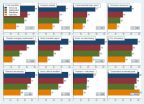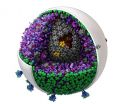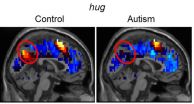Stroke researchers link frontal lesions with improved spatial neglect after prism therapy
Integrity of medial temporal structures in the frontal lobe may support functional improvement after prism therapy
2014-12-02
(Press-News.org) West Orange, NJ. December 2, 2014. Stroke researchers have found that the presence of frontal lesions predicts better functional improvement in individuals with spatial neglect who received prism adaptation therapy. "Integrity of medial temporal structures may predict better improvement of spatial neglect with prism adaptation treatment" (doi: 10.1007/s11682-012-9200-5) was published in September in the Neuroimaging and Rehabilitation Special Issue of Brain Imaging & Behavior. The authors are Peii Chen, PhD, Priyanka Shah, and A.M. Barrett, MD, of Kessler Foundation, Kelly M. Goedert of Seton Hall University, and Anne L. Foundas of the University of Missouri.
The study was conducted in 21 patients with left-sided spatial neglect, a common complication of right-brain stroke. The participants underwent 2 weeks of prism adaptation treatment, and 4 weeks of followup. Examination of clinical scans showed that 3 participants had frontal lesions; 8 had no frontal lesions. "Functional improvement was seen after treatment," noted Dr. Chen, "but not equally among the patients. Those with lesions of the frontal cortex had much greater improvement than those without these lesions. Further examination using voxel-based lesion-behavior mapping revealed that in this group, the integrity of medial temporal structures had been maintained. Additional research is needed to determine the course of spatial neglect in this subset of patients, and whether they may respond better to prism therapy."
INFORMATION:
The study was funded by the National Institutes of Neurological Disorders & Stroke (R01 NS055808, Barrett), the Eunice Kennedy Shriver Institute of Child Health & Development (K24 HD062647, PI, Barrett), and Kessler Foundation.
About Stroke Rehabilitation Research at Kessler Foundation
Research studies span all domains of post-stroke cognitive dysfunction, but emphasize hidden disabilities after stroke, including hidden disabilities of functional vision (spatial bias and spatial neglect). Students, resident physicians, and post-doctoral trainees are mentored in translational neuroscience of rehabilitation. Dr. Barrett and her colleagues work closely with the clinical staff at Kessler Institute for Rehabilitation. Among their collaborative efforts are the founding of the Network for Spatial Neglect and development of the Kessler Foundation Neglect Assessment Process (KF-NAPTM). Stroke Research receives funding from the Department of Education/NIDRR; the National Institutes of Neurological Disorders & Stroke, the National Institutes of Health/NICHD/NCMRR; Kessler Foundation; the Healthcare Foundation of New Jersey; and the Wallerstein Foundation for Geriatric Improvement. Scientists have faculty appointments at Rutgers New Jersey Medical School.
About A.M. Barrett, MD
A.M. Barrett, MD, a cognitive neurologist and clinical researcher, studies brain-behavior relationships from the perspectives of cognitive neurology, cognitive neuroscience, and cognitive neurorehabilitation. Dr. Barrett is an expert in hidden cognitive disabilities after stroke, which contributes to safety problems & rehospitalization, increased caregiver burden, & poor hospital-to-home transition. She is a founder of the Network for Spatial Neglect, which promotes multidisciplinary research for this underdiagnosed hidden disability. Dr. Barrett is also professor of physical medicine & rehabilitation at Rutgers New Jersey Medical School and adjunct professor of neurology at Columbia University School of Medicine. She is a former president of the American Society for Neurorehabilitation.
Dr. Barrett is author of the reference article Spatial Neglect on emedicine.com.
Relevant publications by Stroke Rehabilitation Research:
Barrett AM, Muzaffar T. Spatial cognitive rehabilitation and motor recovery after stroke. Curr Opin Neurol 2014;27:653-8. doi: 10.1097/WCO.0000000000000148
Barrett AM. Picturing the body in spatial neglect: descending a staircase. Neurology. 2013 Oct 8;81(15):1280-1.
Goedert KM, Chen P, Boston RC, Foundas AL, Barrett AM. Presence of motor-intentional aiming deficit predicts functional improvement of spatial neglect with prism adaptation. Neurorehabilitation and Neural Repair epub Dec 27 2013. DOI: 10.1177/1545968313516872
Barrett AM, Oh-Park M, Chen P, Ifejika NL. Five new things in neurorehabilitation. Neurology Clinical Practice. Epub Nov 13 2014. doi: 10.1212/01.CPJ.0000437088.98407.fa.
About Kessler Foundation
Kessler Foundation, a major nonprofit organization in the field of disability, is a global leader in rehabilitation research that seeks to improve cognition, mobility and long-term outcomes, including employment, for people with neurological disabilities caused by diseases and injuries of the brain and spinal cord. Kessler Foundation leads the nation in funding innovative programs that expand opportunities for employment for people with disabilities. For more information, visit KesslerFoundation.org; Facebook.com.KesslerFoundation; Tweet us @KesslerFdn
Contacts:
Carolann Murphy, 973.324.8382, CMurphy@KesslerFoundation.org
Lauren Scrivo, 973.324.8384, 973.768.6583 - c, LScrivo@KesslerFoundation.org
ELSE PRESS RELEASES FROM THIS DATE:
2014-12-02
To arrange for an interview with a researcher, please contact the Communications staff member identified at the end of each tip. For more information on ORNL and its research and development activities, please refer to one of our media contacts. If you have a general media-related question or comment, you can send it to news@ornl.gov.
IMAGING - Clearer brain scans ...
A clever signal noise reduction strategy developed by a team that includes Oak Ridge National Laboratory's Ben Lawrie could dramatically improve brain imaging. By using quantum correlated beams of light, ...
2014-12-02
New Rochelle, NY, December 2, 2014--A study of active duty U.S. Marines who suffered a recent or previous concussion(s) examined whether persistent post-concussive symptoms (PPCS) and lingering effects on cognitive function are due to concussion-related brain trauma or emotional distress. The results are different for a recent concussion compared to a history of multiple concussions, according to the study published in Journal of Neurotrauma, a peer-reviewed journal from Mary Ann Liebert, Inc., publishers. The article is available Open Access on the Journal of Neurotrauma ...
2014-12-02
DURHAM, N.H. - Environmentalists dispirited by the Republicans' dominance of the recent midterm elections can take heart: non-Tea Party Republicans' views on science and environmental issues are closer to those of Independents than to Tea Party supporters. That's the primary finding of new research by University of New Hampshire sociologists, published this week in the journal Environmental Politics.
"Across a range of science and environmental issues, non-Tea Party Republicans are more similar to Independents than they are to Tea Party supporters, and those divisions ...
2014-12-02
Witnessing violence by parents or a parent's intimate partner can trigger a chain of negative behaviors in some children that follows them from preschool to kindergarten and beyond, according to researchers at Case Western Reserve University.
But girls and boys can be affected differently, researchers concluded. While girls tend to internalize their exposure to such violence, boys are more inclined to act out aggressively, said Megan R. Holmes, PhD, MSW, assistant professor at the Jack, Joseph and Morton Mandel School of Applied Social Sciences at Case Western Reserve ...
2014-12-02
The Valle de Aguán spiny-tailed iguana is a critically endangered species found in Honduras. A recent survey of people living in the region shows that, although residents are aware of the endangered status of the species, the iguana continues to be hunted for food. Of particular concern is the preference for the consumption of female iguanas that are gravid (carrying eggs in their body).
"In this study we worked to gain a better understanding of how humans are harvesting the species for food," said Stesha Pasachnik, Ph.D., a lead researcher on the study and ...
2014-12-02
LA JOLLA, CA - December 1, 2014 - Researchers can now explore viruses, bacteria and components of the human body in more detail than ever before with software developed at The Scripps Research Institute (TSRI).
In a study published December 1 in the journal Nature Methods, the researchers demonstrated how the software, called cellPACK, can be used to model viruses such as HIV.
"We hope to ultimately increase scientists' ability to target any disease," said Art Olson, professor and Anderson Research Chair at TSRI who is senior author of the new study.
Putting cellPACK ...
2014-12-02
PROVIDENCE, R.I. [Brown University] -- If decades of effort to bring more underrepresented minority students into science, technology, engineering and mathematics (STEM) fields were considered a grand chemistry experiment, then the modest results would suggest that while the formula may not be wrong, it may well be incomplete, according to a new article in the journal CBE-Life Sciences Education.
"I don't necessarily want to say that we've been doing it wrong all along, it's just that there are other ideas we can bring in," said lead author Andrew G.Campbell, a Brown ...
2014-12-02
West Orange, NJ. December 1, 2014. Kessler Foundation researchers have authored a new article that provides insight into the variable impact of traumatic brain injury (TBI) on long-term memory. The article, "Working memory capacity links cognitive reserve with long-term memory in moderate to severe TBI: a translational approach," was epublished ahead of print on October 7 in the Journal of Neurology (10.1007/s00415-014-7523-4). The authors are Joshua Sandry, PhD, John DeLuca, PhD, and Nancy Chiaravalloti, PhD, of Kessler Foundation. This study was supported by grants ...
2014-12-02
A new method for determining lung cancer risk could more efficiently identify individuals for annual screening and catch more cancers early, according to a study published in this week's PLOS Medicine. The study, conducted by Martin Tammemägi of Brock University, Canada, and colleagues, evaluates a lung cancer risk prediction model and identifies a risk threshold for selecting individuals for annual lung cancer screening.
Computed Tomography (CT) screening can identify lung tumors while they are still treatable, and the US National Lung Screening Trial (NLST) found ...
2014-12-02
PITTSBURGH--Psychiatric disorders -- including autism -- are characterized and diagnosed based on a clinical assessment of verbal and physical behavior. However, brain imaging and cognitive neuroscience are poised to provide a powerful advanced new tool.
Carnegie Mellon University researchers have created brain-reading techniques to use neural representations of social thoughts to predict autism diagnoses with 97 percent accuracy. This establishes the first biologically based diagnostic tool that measures a person's thoughts to detect the disorder that affects many children ...
LAST 30 PRESS RELEASES:
[Press-News.org] Stroke researchers link frontal lesions with improved spatial neglect after prism therapy
Integrity of medial temporal structures in the frontal lobe may support functional improvement after prism therapy





